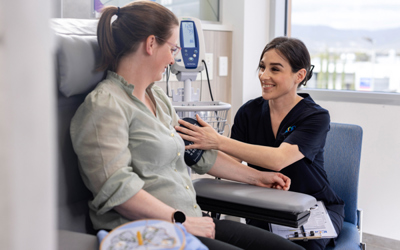What are the treatment options for cervical cancer?
The primary treatment options for cervical cancer include surgery, radiotherapy, chemotherapy and targeted therapy. The type of treatment you receive will depend on a number of different considerations, such as the type of cervical cancer you have, its stage, your overall health and your treatment preferences. This page aims to give you a comprehensive overview of how cervical cancer treatment works.
Surgery for cervical cancer
Surgery is usually recommended for women who have a tumour that is confined to the cervix. The type of surgery you have will depend on how far within the cervix the cancer has spread and whether you want to be able to have children.
Surgical options for patients include:
-
Biopsy
A cone biopsy is used to diagnose cervical cancer and can be used to treat early and small tumours. The procedure involves removing a cone shaped section of the cervix where the cancer has been detected. This surgical procedure is suitable for patients who wish to maintain their fertility.
-
Trachelectomy
A trachelectomy refers to the surgical removal of the cervix. This type of surgery is often used to treat small cancers in young women who wish to remain fertile and will allow you to continue menstruating regularly. This surgical procedure is suitable for patients who wish to maintain their fertility.
-
Lymphadenectomy
For some women, lymph nodes in your pelvic region may be removed as a staging procedure to see if cancer cells have spread. This procedure is referred to as a lymphadenectomy. This surgical procedure is suitable for patients who wish to maintain their fertility.
-
Hysterectomy with bilateral salpingo-oophorectomy
A hysterectomy with bilateral salpingo-oophorectomy refers to the surgical removal of the uterus, both fallopian tubes and both ovaries. In some cases, you may only require a hysterectomy, preserving your ovaries. This surgical option is suitable for patients when remaining fertile is not a priority.
-
Pelvic exenteration
A pelvic exenteration involves removing all or part of the cancerous tissue and is more commonly used in cases where cancer has returned and has not spread. This surgical option is suitable for patients when remaining fertile is not a priority.
Radiotherapy for cervical cancer
Most women who have radiotherapy for cervical cancer will receive both external and internal radiotherapy.
External beam radiotherapy
External beam radiotherapy is used to treat cervical cancer by delivering radiotherapy beams to the cervix, lymph nodes and adjacent tissues where cancerous cells may have spread. Most patients will receive EBRT five days per week for five to six weeks.
Internal radiotherapy
This procedure is also known as brachytherapy. For cervical cancer, a radiation source is placed inside the body next to the cancer in the cervix. This reduces the effect radiation has on nearby organs such as the bowel and bladder.
Targeted therapy for cervical cancer
Targeted therapies use specialised drugs to destroy specific proteins in cervical cancer cells and are commonly used to treat advanced cervical cancer and cervical cancer that has returned (recurrent cancer).
Common targeted therapies used to treat cervical cancer include:
Bevacizumab - This is a targeted therapy drug used to treat advanced cervical cancer. It is usually given together with other chemotherapy drugs as an intravenous infusion every three weeks.
Chemotherapy for cervical cancer
Chemotherapy uses a range of drugs to kill and slow the growth of cervical cancer cells. Typically, cervical cancer patients will receive low dose weekly chemotherapy alongside radiotherapy, which helps the radiotherapy to treat your cancer more effectively. This treatment method is known as concurrent chemoradiation and is the preferred treatment method for locally advanced cervical cancers.
Learn more about chemotherapy and how it is delivered.
Chemotherapy treatment for cervical cancer takes place over several sessions, known as a cycle. Your care team will walk you through how many cycles you may need for your course of treatment, with most people completing chemotherapy in a period of five to six weeks.
Common chemotherapy medicines
There are a number of different chemotherapy drugs that are used to treat cervical cancer. These drugs are typically combined based on factors such as the type of cervical cancer you have, your cancer’s stage and how much it has spread. Some of the drugs used include:
-
This is a drug that is used together with radiotherapy to treat cervical cancer. It is used as a radiosensitiser to help the radiotherapy work more effectively.
-
This is a type of chemotherapy drug that contains platinum. It is usually given in combination with other drugs such as bevacizumab and paclitaxel to treat advanced cervical cancer.
-
This chemotherapy drug is usually given in combination with other chemotherapy drugs (for example, bevacizumab and cisplatin) to treat advanced and recurrent cervical cancer.
-
Belonging to a class of chemotherapy drugs known as antimetabolites, 5-fluorouracil may be used together with cisplatin as part of chemoradiation treatment to sensitise the cancer cells to radiotherapy.
Clinical trials for cervical cancer
Icon offers a wide range of clinical trials providing patients with access to new and evolving treatments. Clinical trials offer hope and opportunity and contribute to breakthroughs in treatment for future cancer patients.

Treatment by stage of cervical cancer
When you are diagnosed with cervical cancer, your oncologist will develop your treatment plan as part of a multidisciplinary team based on the stage of your cancer and whether you would like to have children.
Learn more about the common treatment options for each stage of cervical cancer include below.
Stage I cervical cancer – confined to the cervix
When cervical cancer is classified as stage I, there are treatment options available to help maintain your fertility. Most of these most treatment plans begin with a biopsy, and in some cases may be followed by a radical trachelectomy if there are cancer cells present in the edges of the biopsy. Some women may also receive a sentinel node biopsy or lymphadenectomy to remove surrounding lymph nodes. If maintaining fertility is not a concern for you, your treatment plan will likely start with a hysterectomy, removing both the cervix and uterus, as well as lymph node staging.
Stages II and III cervical cancer – extending to nearby tissues and/or lymph nodes
Similar to stage I cervical cancer treatment, stage II and stage III cervical cancer may be treated with a radical hysterectomy and lymphadenectomy first followed by radiotherapy. Some women will also be treated with chemotherapy to help increase the effectiveness of their radiotherapy treatment. Some women may receive chemo-irradiation without further surgery, depending on response to treatment.
Stage IV cervical cancer
Stage IV cervical cancer is commonly treated through concurrent chemoradiation. However, if the cancer has spread to distant sites and is classified as stage IVB, it is no longer considered curable in most cases and treatment will focus on palliative care. Treatment options will typically include radiotherapy and may be given alongside chemotherapy and targeted therapies to relieve your symptoms.









